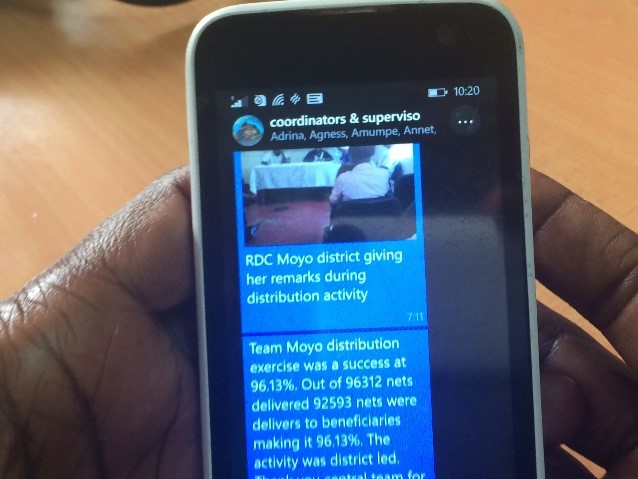Innovative use of WhatsApp during the February 2017 Ugandan universal net coverage campaign led to improved central coordination, efficient decision-making and improved information sharing.
Background
In 2013-14, Uganda launched its first universal net coverage campaign that aimed to provide long-lasting insecticide-treated mosquito nets (LLINs) to millions across the country. During the campaign, subcommittees were created to ensure central coordination of various aspects of the distribution, such as technical, logistics, behavior change communication, and social mobilization. However, coordination among the subcommittees was a challenge that limited full stakeholder engagement during the universal net coverage campaign.
The second universal net coverage campaign was launched in February 2017. The National Malaria Control Programme, supported by USAID’s Malaria Action Program for Districts sought to improve communication between subcommittees through the innovative use of the smartphone messaging application, WhatsApp. The application was used to coordinate responses during the 2017 campaign – whereas during the 2013-14 campaign, email and mobile phones were used as the main communication platform.
Innovative Use of ‘WhatsApp’
“WhatsApp is almost free and is consequently a very good solution for me with a limited budget. Here I can reach my 22 sub-county supervisors, using less than 1kb of data, which is a lifesaver if I had to call all 22 supervisors and deliver the same message.”
Julius Lukwago, District Coordinator, Lira
The use of WhatsApp for troubleshooting was found to be effective, particularly to address issues around data verification, changes in delivery and other schedule deadlines, and to share and discuss ways to overcome these challenges. The national and district distribution teams set up a WhatsApp group which consisted of National Malaria Control Program team leaders, district supervisors, coordinators and sub-county supervisors.
One of the most valuable uses of WhatsApp was its ability to share photos easily to show emerging issues. For example, staff took pictures of damaged bales and shared them with the group and instant solutions were given. The group was constantly kept up-to-date on emerging issues, and discussions were started involving staff with different technical specialties to address a wide range of issues. Sharing photos of successes also served as a morale booster. WhatsApp was also useful in instances when team leaders needed to communicate with their team using the audio function. Individuals were able to send messages by recording their own voice, and complement this with pictures and videos, which succeeded in conveying messages more clearly and timely than other methods.
WhatsApp has proven to be a simple communication tool that can reach many individuals and groups at once, thus keeping district officials, implementing staff, and all involved in the distribution up-to-date with plans and developments in the campaign. The messenger application is installed on most smartphones and is now used by all age groups, making it easy to use and cost-effective.
Successes
“WhatsApp is instant and a simple tool for providing information and coordination; in my case, I simply voice record instructions and share them on the chat group.”
Geoffrey Ssenvuma, District Coordinator, Apac
One of the features that made WhatsApp unique and effective during the project’s February 2017 distribution was called ‘broadcast group’, which made it possible to send a message to several people at the same time. District supervisors and coordinators were able to make quick decisions on field challenges using this function.
Supervisors used the audio function to communicate with their team by recording voice messages rather than sending a written message, to save time and to relay messages more clearly.
The group feature was also used for communication with teams in remote locations and where network connections were often unreliable; using WhatsApp, the messages were received as soon as team members were able to access a network connection.
Lessons and Next Steps
“I love its flexibility in sharing multimedia, delivery of text, voice, picture and video messages and also emojis. It thus permits me to be versatile and [expressive] in my content.”
Jude Okiria, District Coordinator, Nebbi
Communication, providing information, and coordination are important aspects in the net distribution campaigns, and WhatsApp offers a solution by providing quicker access to multiple people at once and better access to supervisors, who may be often hard to reach, sub-county teams, and central coordinating committees.
Various campaign subcommittees have different needs, and using WhatsApp groups enables content to be tailored appropriately to subcommittees. This has made decision-making faster, has encouraged better information sharing and transparency, and has made emergency response work across many levels easier.
The WhatsApp feature that teams found most useful was the ability to send voice recordings to WhatsApp contacts and groups. While this does not replace real-time conversations, they made communication easier for people. In addition, hearing the voice of a supervisor was more personal and motivating.
The WhatsApp function to share current location has helped track the user’s location at a particular time. This has been useful in emergency cases where users needed to be located, as well as for supervisors who need to track the coverage of sub-county teams.
WhatsApp has proved to be a beneficial tool to reach and send information to a wider group, as seen during the 2017 net distribution campaign. USAID’s Malaria Action Program for Districts is now exploring the possibility of sending malaria newsletters and videos, pictures, text and links via WhatsApp for easier communication and dissemination amongst the malaria-implementing partners.

